We recently analyzed data from 125,000+ resumes and compiled those resume statistics to answer one question:
How many candidates are following best practices and where are there opportunities to create a better, more effective resume?
- We looked at file types and formatting.
- We looked at contact information, education, and interests.
- We looked at keywords, skills, and experience.
- We even looked at the specific language used to write these resumes.
The analysis of these resumes led to some pretty interesting results and the goal of this article is to share them with you so that you can understand how to write an effective resume and get an edge on the competition.
Resume Statistics: A Summary Of Our Key Findings
- Including a LinkedIn profile has been shown to boost interview rates, but only 48% of resumes included a link to a LinkedIn profile
- Including relevant skills and keywords boosts your chances of landing an interview, but candidates only included 51% of relevant keywords in their resume (with a 60% match rate for hard skills and only a 28% match rate for soft skills)
- Metrics and numbers are a best practice for illustrating and selling a candidate's value, but only 26% of resumes included at least five instances of measurable results, metrics, or value and 36% of resumes had zero instances of metrics
- Recent data shows that the ideal resume length is 475 – 600 words, 77% of resumes were outside of that range
- One of the easiest ways to lose your reader is by including too much fluff and too many irrelevant buzzwords — 51% of resumes included fluffy buzzwords, cliches, or the incorrect use of pronouns
You can find detailed data and information on all of these findings in the sections below.
Where Are These Resume Statistics Coming From?
Last year, we launched a free resume scanner and optimization tool called ResyMatch.io.
The goal of ResyMatch is simple: to help job seekers efficiently optimize their resumes so they land more interviews and offers when they apply for jobs.
Here's how it works.
First, a candidate will either upload or paste their existing resume into the left hand field on the ResyMatch homepage. Next, they will paste the entire job description and job title for their target role on the right hand side of the home page:
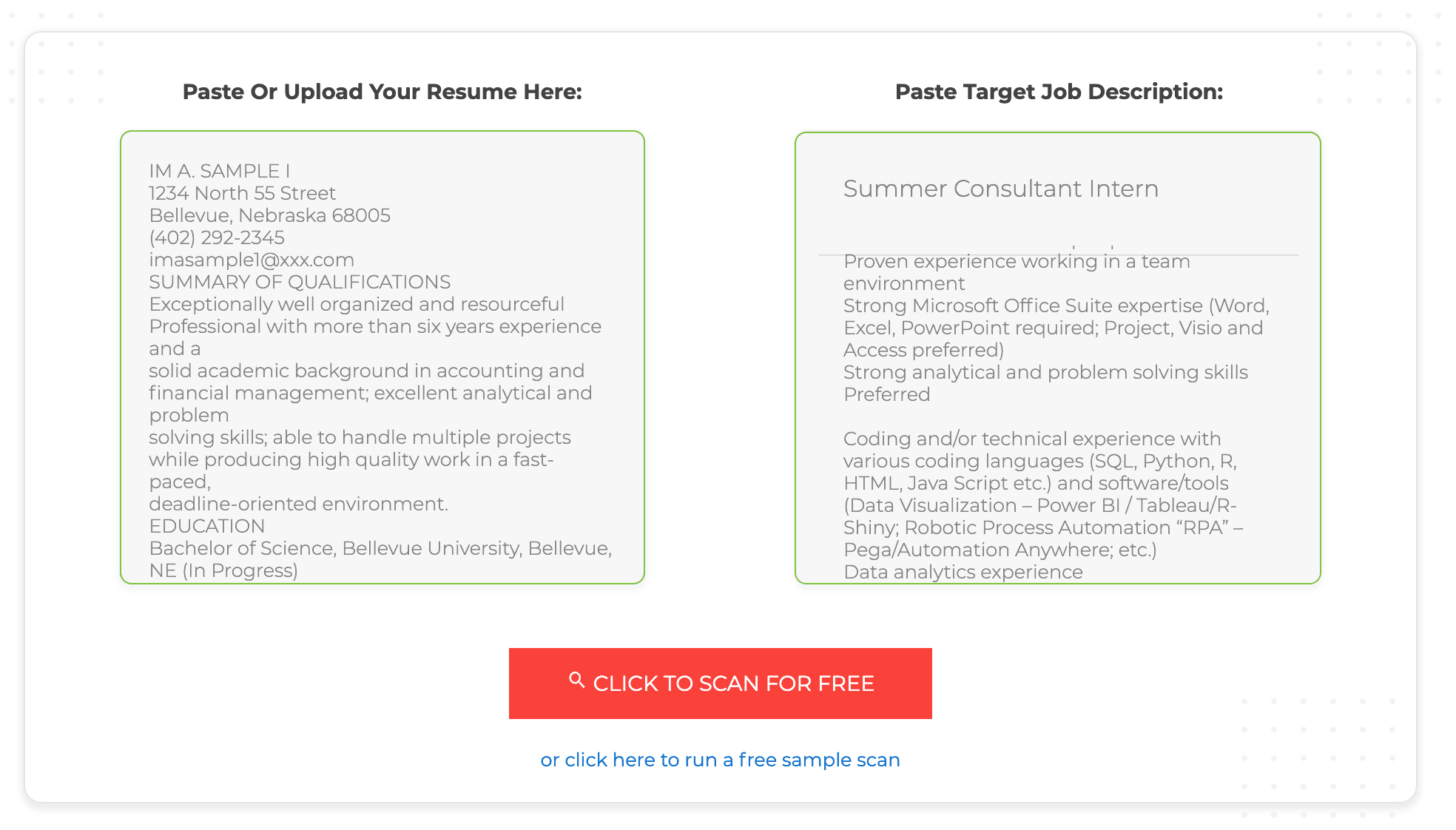
When they hit scan, ResyMatch will analyze the candidates resume against the job description as well as our proprietary database of best practices, keywords, skills, and experience. ResyMatch will calculate a score from 0-100 for their resume and share that score along with specific insights, data, and best practices.
Since its launch, candidates and job seekers have used ResyMatch to scan 125,000+ resumes (125,484 at the time of writing this to be exact). The data from those scans is the basis for the analysis you'll find in this article.
It's important to note that a person's first scan is the best representation of their unoptimized resume. For example, a first scan might not include a link to a LinkedIn Profile, but subsequent scans will likely have that link since the tool recommends making that change. We looked at “first scan” data where applicable in order to get a clear, accurate picture of the data. In other cases, like identifying the keyword density in a job description, we used the full spectrum of job descriptions available in the database.
Finally, this data has not been scientifically gathered or reviewed. The data was collected via our ResyMatch tool and analyzed by our team. The purpose of this post is to share the data we've collected, to draw casual conclusions, and to point out potential correlations and opportunities to help job seekers and resume writers make more effective decisions.
1. Resumes With A LinkedIn Profile See Higher Interview Rates, But Only 48% Of Resumes Included A LinkedIn Profile
According to research from ResumeGo, resumes that include a link to a comprehensive LinkedIn profile have a 71% higher chance of getting a job interview.
According to ResumeGo, “job applicants who included a link to a comprehensive LinkedIn profile on their resumes received a callback rate of 13.5%, which is 71% higher than the 7.9% callback rate of job applicants who didn’t have a LinkedIn profile at all.”
Here is a visualization of that data:
 Our resume statistics show that only 48% of resumes scanned via our ResyMatch tool include a link to a LinkedIn profile. For comparison, 85% of resumes included an email address and 78% included a phone number:
Our resume statistics show that only 48% of resumes scanned via our ResyMatch tool include a link to a LinkedIn profile. For comparison, 85% of resumes included an email address and 78% included a phone number:
 Key Takeaway: Candidates can drastically increase their chances of landing an interview if they include a link to their LinkedIn profile on their resume, but most candidates are not. This creates an advantage for job seekers who have optimized their LinkedIn profile and are including it on their resume. In other words, make sure to add a link to your LinkedIn profile on your resume!
Key Takeaway: Candidates can drastically increase their chances of landing an interview if they include a link to their LinkedIn profile on their resume, but most candidates are not. This creates an advantage for job seekers who have optimized their LinkedIn profile and are including it on their resume. In other words, make sure to add a link to your LinkedIn profile on your resume!
2. Candidates Only Included 51% Of Important Keywords And Skills, Heavily Under-Indexing On Soft Skills
Including relevant keywords and skills on your resume is important for two reasons:
First, Applicant Tracking Systems use specific keywords, skills, and experience to filter (and in some cases score/rank) resumes. Second, when recruiters and hiring managers review resumes they are looking for specific skills and experience to help qualify candidates and compare them to the rest of the pool.
If a candidate doesn't include the right keywords on their resume, their chances of landing an interview decreases significantly — especially if they are using online applications as their primary method for chasing new opportunities.
For each resume scan, our ResyMatch tool identifies keywords in both the resume and the job description. Next, ResyMatch will compare the resume and the job description to see which keywords overlap and at what frequency.
Job Descriptions Contain 37 Instances of Keywords And Skills On Average
A natural question here might be, “how many keywords exist in an average job description?” After all, if our goal is to include them in our resume, it's helpful to know how many exist in the first place.
Our data shows that the average job description includes 43 keywords (rounded down from 43.48), with a median of 39 keywords. Here is a breakdown of keyword frequency across job descriptions:
 Candidates Only Matched 51% of Relevant Keywords And Skills On Their Resumes
Candidates Only Matched 51% of Relevant Keywords And Skills On Their Resumes
Our resume statistics showed that candidates' resumes only included 51% of the keywords and skills that appeared on the job description. In other words, their resumes didn't about half of the keywords and skills that were present in the job description and relevant to the role.
When broken down into skill types, candidates' resumes included 60% of the necessary hard skills and only 28% of the necessary soft skills when compared to their target role's job description:
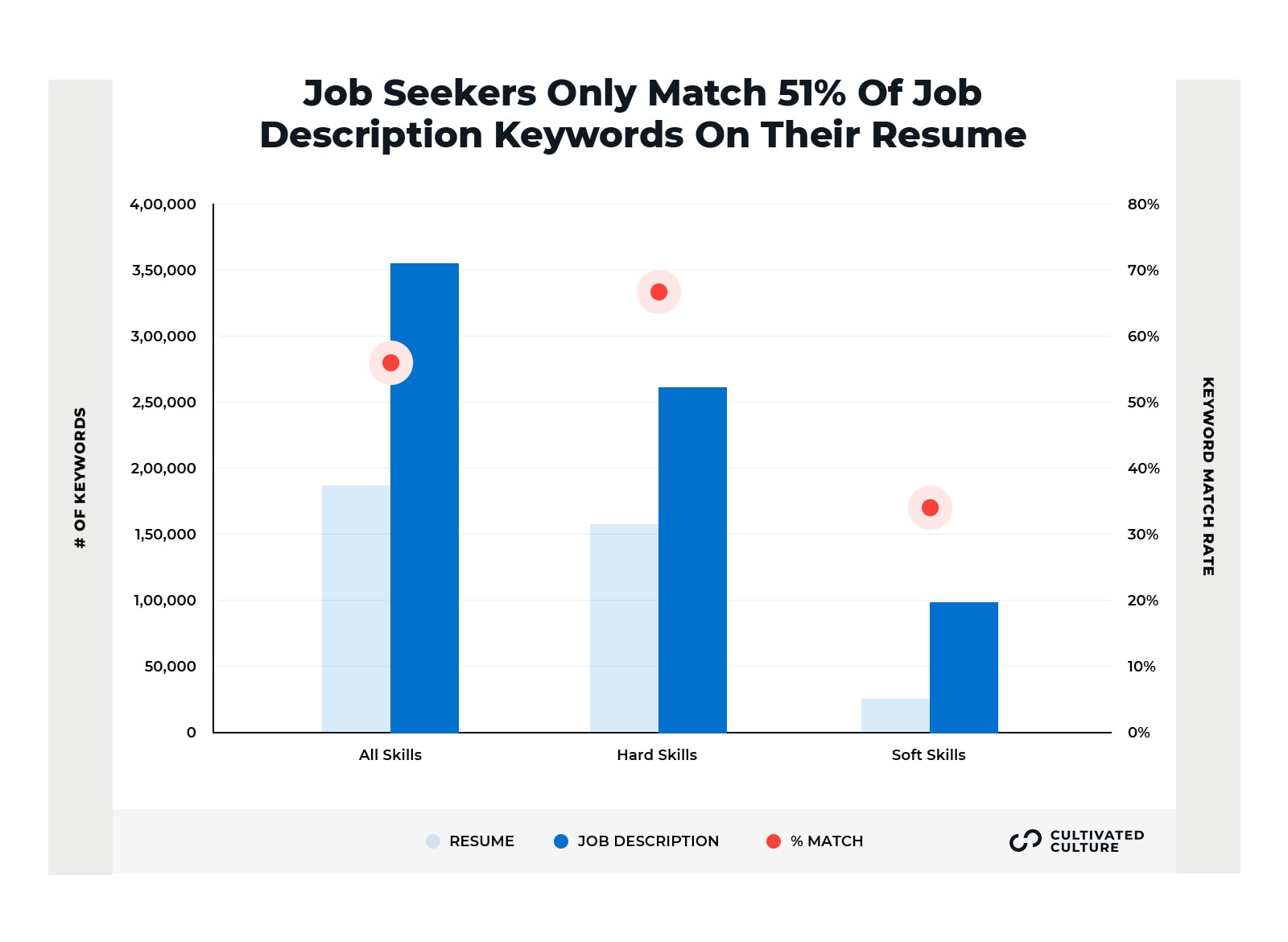 Key Takeaway: Keywords and skills are a primary factor in success when it comes to applying for jobs online. However, most job seekers don't do a good job of including relevant hard skills, soft skills, and other keywords into their resume.
Key Takeaway: Keywords and skills are a primary factor in success when it comes to applying for jobs online. However, most job seekers don't do a good job of including relevant hard skills, soft skills, and other keywords into their resume.
To gain a leg up on the competition, job seekers can use a tool like ResyMatch.io to better understand the skills and keywords they should be including in order to increase their chances of getting a call back for an interview.
Note: While including keywords and skills is important, it's equally important to write naturally and focus on illustrating your value. Resumes that over-index on keywords can seem robotic or, in some cases, disingenuous. You should include as many keywords as you can naturally fit into your resume, but do not keyword stuff for the sake of getting a higher score (or a “perfect” score) from resume scanning tools.
3. Measurable Metrics Improve Resume Outcomes, But Only 26% Of Resumes Included Five Or More Metrics
A quick online search will tell you that recruiters and employers prefer resumes with measurable metrics and quantifiable results. For example, this article mentions that Google's recruiters specifically recommend a framework called the “XYZ Formula” for writing resume bullets that focuses on including measurable outcomes.
Why do companies prefer resumes with metrics? Because metrics make value easier to understand and quantify.
If ten candidates all say they were “responsible for planning and executing social media campaigns,” it's hard to know who did it well and who didn't. Anyone can plan a campaign and anyone can execute that plan. But did the plan result in any tangible outcomes? Did it increase followers? Sales?
That information is hard to know if the candidate doesn't mention the outcomes on their resume, which seems to be the case across most resumes.
For ResyMatch's scoring algorithm, we set our measurable metrics parameter at five instances. Resumes with five or more instances of measurable metrics “pass” and get additional points towards their total resume score. To clarify, five instances is still fewer than we'd recommend in an ideal world, but we wanted to make it achievable for candidates since we knew that many people don't include metrics at all.
Our data shows that only 26% of resumes included five or more instances of measurable metrics. In fact, 36% of resumes didn't include a single measurable metric whatsoever:
 Key Takeaway: If you want to stand out from the competition, focus on quantifying your results and including metrics in your resume. If it's helpful, you can use the XYZ formula from the article mentioned above. It goes like this:
Key Takeaway: If you want to stand out from the competition, focus on quantifying your results and including metrics in your resume. If it's helpful, you can use the XYZ formula from the article mentioned above. It goes like this:
The X-Y-Z Resume Bullet Formula
• Accomplished [X] as measured by [Y], by doing [Z].
For example, “Increased QoQ sales 17% by designing new conversion-focused Facebook Ad imagery.”
It's important to realize that metrics aren't exclusive to revenue or sales. Think of these categories and examples as well:
Scope – How many teams or people worked on this project? Did the project have a budget? Was there a goal that was set for success?
Efficiency / Productivity – Was the projected completed ahead of time (if so, by how much)? Did your work improve efficiency or reduce waste? Were you able to cut costs or save money? Did you reduce the amount of hours a team or individual needs to spend on a task?
Quantity – What amount do you produce? How many cold emails do you send per day? How many graphics do you create? How does this compare to your colleagues or the average?
Leveraging Others – Can you find teams that leveraged your work to produce outcomes? For example, let's say you are a graphic designer and you created new images for Facebook ads. Can you go to the marketing team and ask how ads with your images performed vs. other ads and campaigns? Did they drive more traffic or sales?
If you need some help, we've created a free tool called ResyBullet.io that will score your resume bullets and help improve them:

All you need to do is copy a bullet from your resume, paste it in, and use the feedback and scoring mechanism to improve!
4. Research Shows The Ideal Resume Length Is 475 – 600 Words, 77% of Resumes Fell Outside Of That Range
A recent TalentWorks article investigated the effects of resume length on job search success. Here is a copy/paste of their methodology:
“We randomly sampled 6,305 applications across 66 industries for 721 different users from TalentWorks. Then for each of those users, we extracted the word count and keyword count (of keywords from a known qualification set) from their resume and calculated their interview rate. Finally, we clipped outliers, then weighted (by number of applications per user) and smoothed the results to find the general trend. All analysis and graphing was done using python with pandas, sklearn, scipy, and bokeh.”
The TalentWorks study showed that, in most cases, resumes clocking in under 475 words or greater than 600 words saw significant decreases in effectiveness:
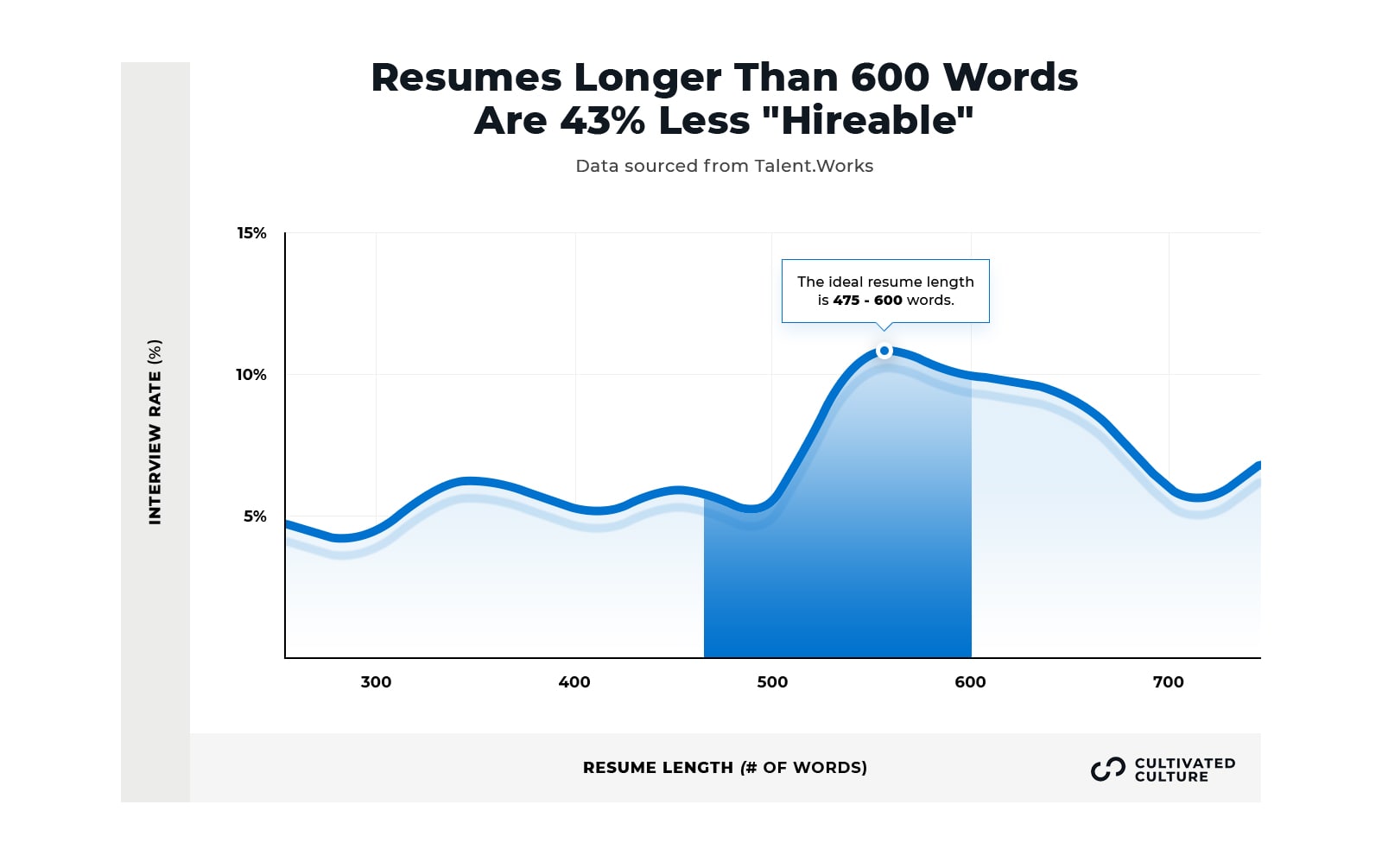 Resumes that were in the “sweet spot” of 475 – 600 words saw double the interviews of those that were outside of those ranges.
Resumes that were in the “sweet spot” of 475 – 600 words saw double the interviews of those that were outside of those ranges.
According to our data, 77% of the resumes scanned with our ResyMatch tool were either under 475 words or over 600 words, giving them a significantly lower chance of receiving interviews when compared to the TalentWorks data. Here is the full distribution:
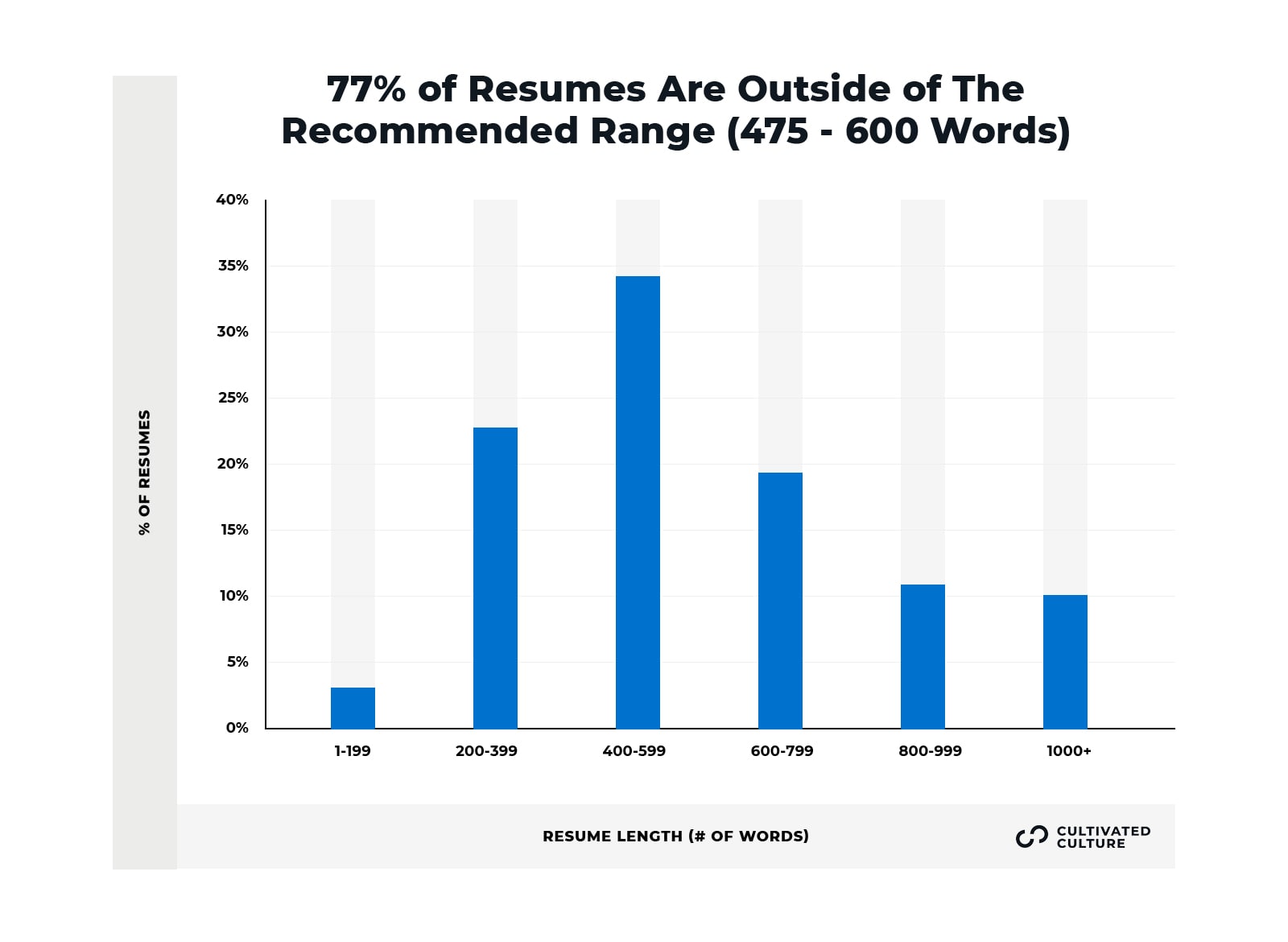 Something to note about this data is that TalentWorks didn't share the career levels of the resumes they used. Executive level resumes do tend to be longer and it's not uncommon to see an 800-1,000+ word executive resume. Additionally, federal positions and fields that focus on CVs instead of resumes usually see success at higher word counts. The resume statistics from TalentWorks is best applied to non-Executive and non-CV focused roles.
Something to note about this data is that TalentWorks didn't share the career levels of the resumes they used. Executive level resumes do tend to be longer and it's not uncommon to see an 800-1,000+ word executive resume. Additionally, federal positions and fields that focus on CVs instead of resumes usually see success at higher word counts. The resume statistics from TalentWorks is best applied to non-Executive and non-CV focused roles.
Our ResyMatch tool currently recommends a range of 400-1,000 words. The good news is that ResyMatch will tell you exactly how many words are in your resume and the TalentWorks range is in our accepted range as well.
Key Takeaway: Unless you're a C-Level exec or a federal employee, keeping your resume in the ballpark of 475 – 600 words should boost your interview chances for two reasons. First, the TalentWorks data suggests that this range is the sweet spot for what hiring managers and recruiters want to see. Second, 77% of your competition is either under or over indexing, creating the opportunity to give yourself an advantage.
There are many easy ways to track your resume's word count. You can use the Word Count data from a ResyMatch scan. You can use the Word Count tool in your word processor (e.g. Microsoft Word, Google Docs). Finally, you can use an online word counter tool like WordCounter.net.
5. Fluffy Content Takes Away From A Resume's Value, But 51% Of Resumes Included Buzzwords, Cliches, or Incorrect Pronouns
Buzzwords and fluff are the bane of every hiring manager's (and good resume writer's) existence. They're also not recommended as a best practice by many major sources (Glassdoor, Business Insider, Monster, the list goes on…).
Resumes that mention what you're responsible for, boast about your synergisitc approach, or talk about how “highly motivated” you are accomplish one thing and one thing only:
They make your reader want to pull their hair out.
I get it. As a job seeker, you want to make sure that people understand that you're a professional – someone to be respected, who adds value. But packing your resume with buzzwords and jargon achieves the exact opposite. It only serves to muddy the waters and make your value harder to understand.
51% of the resumes in our data set included some sort of buzzword, cliche, or improper use of pronouns (the use of pronouns for anything other than gender identification):
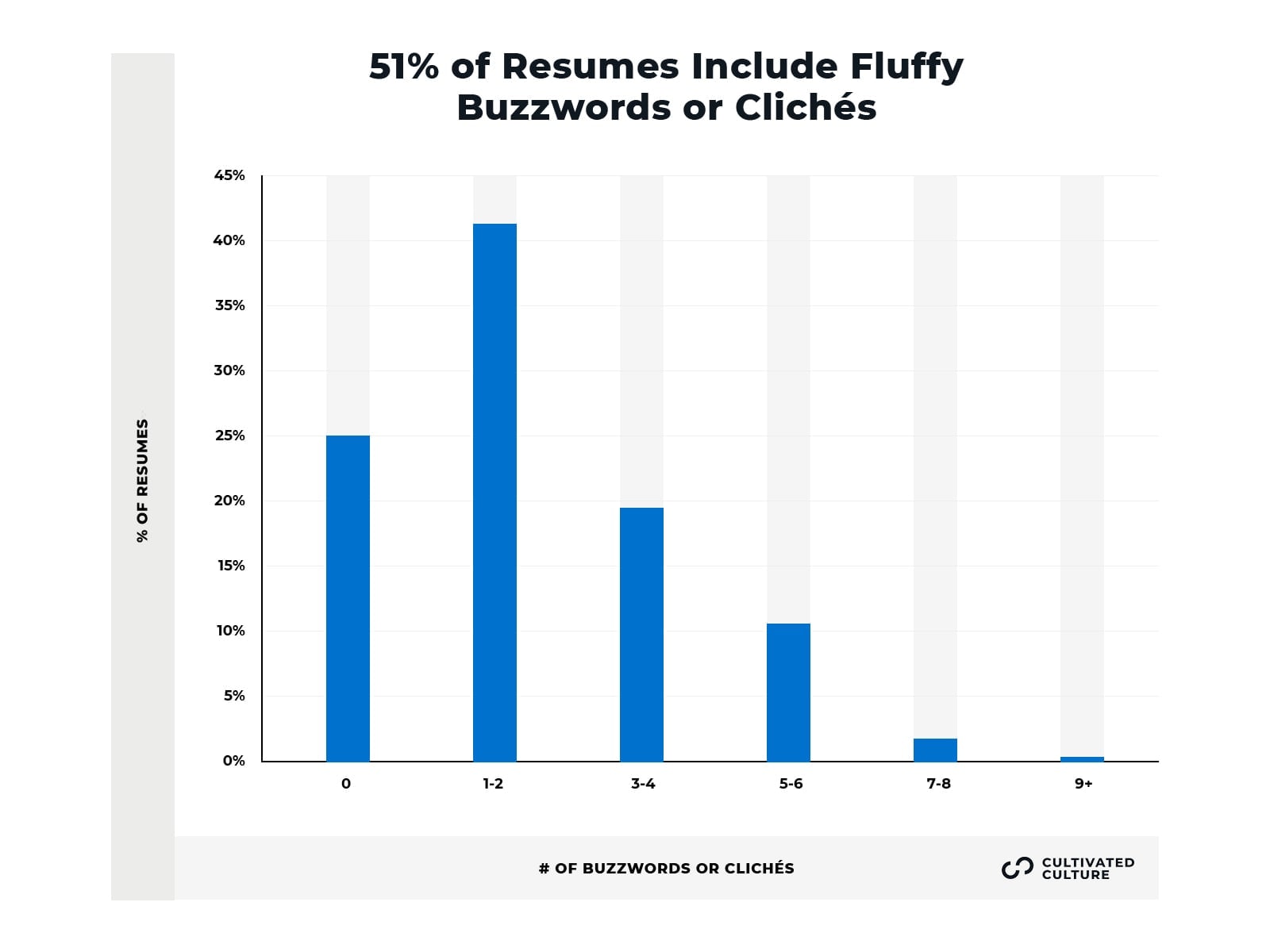 The good news is that the vast majority of these resumes only have one or two instances, which makes for an easy fix.
The good news is that the vast majority of these resumes only have one or two instances, which makes for an easy fix.
Key Takeaway: Our mantra for resumes is that your writing should always be selling your experience, not summarizing it. Concision is at the core of great persuasive writing – the shorter and simpler your sentences, the easier it is to convey your value.
Buzzwords, fluff, and cliches are unnecessary and take away from your message, but the vast majority of resumes include them. If you take a few extra minutes to remove them from your bullets and focus on writing in the style / format mentioned earlier in this post, your value will be clear and you will stand out from the crowd!
Conclusion: Our #1 Takeaway From These Resume Statistics (What's Yours?)
While there is a lot of resume advice and information out there on the web, there are specific, standard best practices that are widely agreed upon in the community. Things like:
- Including an email address, phone number, and LinkedIn profile on your resume
- Adding relevant keywords and experience from the job description into your resume
- Leveraging measurable metrics to illustrate your value in a concrete way
- Avoiding fluff when writing your resume bullets
- Etc.
Our team's #1 takeaway from these resume statistics are that candidates don't do a great job of nailing the basics. Most resumes don't capitalize on basic best practices that have been proven to lead to more job interviews.
What does this mean? As a job seeker, it means there is a lot of low hanging fruit that you can leverage to give yourself an advantage. Rather than spending hours and hours worrying about one page vs. two, or what font size you're using, focusing your efforts on the tactics from this article (and in our guide on writing a great resume) will lead to more interviews and better results.
Now we're curious…
What was your #1 takeaway from these resume statistics? Let us know by dropping a comment below the post. We'd love to discuss!
Thoughts, Feedback, Suggestions For Next Time?
Our goal is to make this a recurring post that's updated with new data on an annual or semi-annual basis. We'd love to hear what you thought about the data, what we could do differently, and what information you'd like to see next time.
If you have a thought, feedback, or a suggestion, feel free to drop it in a comment below or reach out to our team using our Contact form.
Finally, if you'd like to use any of the images from our resume statistics post, you can find full resolution copies through this link. We just ask that you link back to this article or our site as the source.




































Thanks Austin for such informative writing.
You’re so welcome Thompson, thanks for the kind words and for checking out the post!